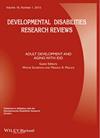{"title":"胎儿和婴儿自发一般运动作为发育障碍的预测因子","authors":"Luba Zuk","doi":"10.1002/ddrr.1104","DOIUrl":null,"url":null,"abstract":"<p>The challenge of identifying infants who are at risk for developmental delay and possible adverse neurodevelopmental outcome demands methods of evaluation that will lead to early intervention to minimize developmental disability and to maximize the infant's potential. A qualitative assessment of spontaneous general movements (GMs) in the preterm, term, and young infant at risk is a valid and reliable tool for evaluation (Prechtl [1990] Early Hum. Dev. 23:151–158). The aim of this review is to describe the theoretical and clinical bases for the assessment of GMs and its relationship to developmental delay and brain dysfunction. Thirty-seven studies related to the predictive validity of GMs were included in this review. Results suggested that consistent cramped synchronized GMs are highly predictive of later development of cerebral palsy. The fidgety movement quality that appears at the age of 2 to 3 months was found to be a most sensitive predictor of neurodevelopmental outcome in different populations of infants. © 2013 Wiley Periodicals, Inc. Dev Disabil Res Rev 2011;17:93–101.</p>","PeriodicalId":55176,"journal":{"name":"Developmental Disabilities Research Reviews","volume":"17 2","pages":"93-101"},"PeriodicalIF":0.0000,"publicationDate":"2013-01-29","publicationTypes":"Journal Article","fieldsOfStudy":null,"isOpenAccess":false,"openAccessPdf":"https://sci-hub-pdf.com/10.1002/ddrr.1104","citationCount":"24","resultStr":"{\"title\":\"Fetal and Infant Spontaneous General Movements as Predictors of Developmental Disabilities\",\"authors\":\"Luba Zuk\",\"doi\":\"10.1002/ddrr.1104\",\"DOIUrl\":null,\"url\":null,\"abstract\":\"<p>The challenge of identifying infants who are at risk for developmental delay and possible adverse neurodevelopmental outcome demands methods of evaluation that will lead to early intervention to minimize developmental disability and to maximize the infant's potential. A qualitative assessment of spontaneous general movements (GMs) in the preterm, term, and young infant at risk is a valid and reliable tool for evaluation (Prechtl [1990] Early Hum. Dev. 23:151–158). The aim of this review is to describe the theoretical and clinical bases for the assessment of GMs and its relationship to developmental delay and brain dysfunction. Thirty-seven studies related to the predictive validity of GMs were included in this review. Results suggested that consistent cramped synchronized GMs are highly predictive of later development of cerebral palsy. The fidgety movement quality that appears at the age of 2 to 3 months was found to be a most sensitive predictor of neurodevelopmental outcome in different populations of infants. © 2013 Wiley Periodicals, Inc. Dev Disabil Res Rev 2011;17:93–101.</p>\",\"PeriodicalId\":55176,\"journal\":{\"name\":\"Developmental Disabilities Research Reviews\",\"volume\":\"17 2\",\"pages\":\"93-101\"},\"PeriodicalIF\":0.0000,\"publicationDate\":\"2013-01-29\",\"publicationTypes\":\"Journal Article\",\"fieldsOfStudy\":null,\"isOpenAccess\":false,\"openAccessPdf\":\"https://sci-hub-pdf.com/10.1002/ddrr.1104\",\"citationCount\":\"24\",\"resultStr\":null,\"platform\":\"Semanticscholar\",\"paperid\":null,\"PeriodicalName\":\"Developmental Disabilities Research Reviews\",\"FirstCategoryId\":\"1085\",\"ListUrlMain\":\"https://onlinelibrary.wiley.com/doi/10.1002/ddrr.1104\",\"RegionNum\":0,\"RegionCategory\":null,\"ArticlePicture\":[],\"TitleCN\":null,\"AbstractTextCN\":null,\"PMCID\":null,\"EPubDate\":\"\",\"PubModel\":\"\",\"JCR\":\"\",\"JCRName\":\"\",\"Score\":null,\"Total\":0}","platform":"Semanticscholar","paperid":null,"PeriodicalName":"Developmental Disabilities Research Reviews","FirstCategoryId":"1085","ListUrlMain":"https://onlinelibrary.wiley.com/doi/10.1002/ddrr.1104","RegionNum":0,"RegionCategory":null,"ArticlePicture":[],"TitleCN":null,"AbstractTextCN":null,"PMCID":null,"EPubDate":"","PubModel":"","JCR":"","JCRName":"","Score":null,"Total":0}
引用次数: 24

 求助内容:
求助内容: 应助结果提醒方式:
应助结果提醒方式:


